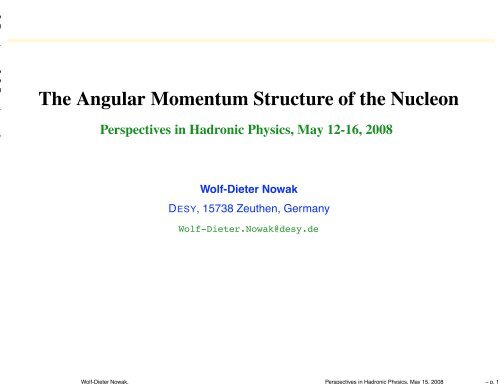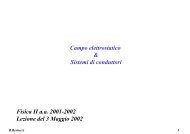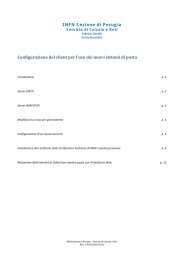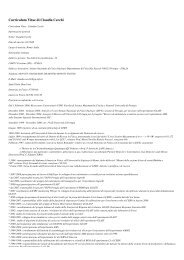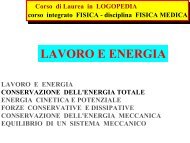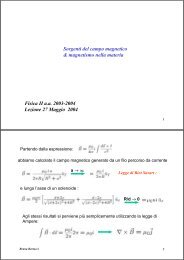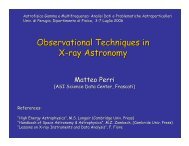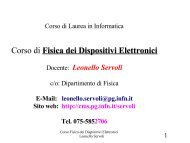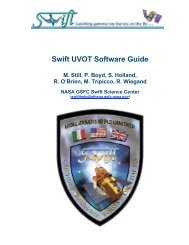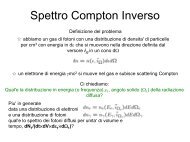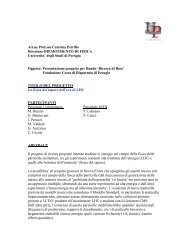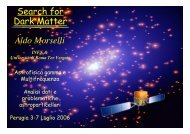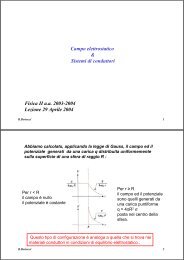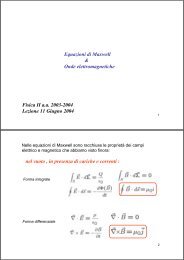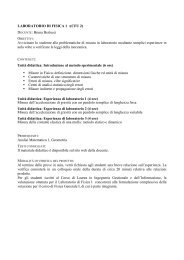W-D. Nowak - INFN
W-D. Nowak - INFN
W-D. Nowak - INFN
You also want an ePaper? Increase the reach of your titles
YUMPU automatically turns print PDFs into web optimized ePapers that Google loves.
Wolf-Dieter <strong>Nowak</strong>, Perspectives in Hadronic Physics, May 15, 2008 – p. 1<br />
The Angular Momentum Structure of the Nucleon<br />
Perspectives in Hadronic Physics, May 12-16, 2008<br />
Wolf-Dieter <strong>Nowak</strong><br />
DESY, 15738 Zeuthen, Germany<br />
Wolf-Dieter.<strong>Nowak</strong>@desy.de
Wolf-Dieter <strong>Nowak</strong>, Perspectives in Hadronic Physics, May 15, 2008 – p. 2<br />
Table of Contents<br />
⊲ 3-dimensional picture of the nucleon<br />
⊲ Proton spin budget in a nutshell<br />
⊲ DIS results: Quark & gluon contributions, QCD fits<br />
⊲ Deeply Virtual Compton Scattering (DVCS)<br />
⊲ Beam-charge and beam-spin asymmetries<br />
⊲ Transverse target-spin asymmetries<br />
⊲ Model-dependent constraints on J u vs. J d<br />
⊲ Summary and Outlook
Wolf-Dieter <strong>Nowak</strong>, Perspectives in Hadronic Physics, May 15, 2008 – p. 3<br />
3-dimensional Picture of the Proton<br />
Nucleon momentum in Infinite Momentum Frame: (p γ<br />
∗ + p nucl ) z → ∞<br />
• Form factor<br />
y<br />
• Parton density<br />
δ z<br />
⊥<br />
xp<br />
y<br />
• Generalized parton<br />
distribution at =0<br />
δ z<br />
⊥<br />
xp<br />
y<br />
b ⊥<br />
z<br />
b ⊥<br />
x<br />
z<br />
x<br />
z<br />
x<br />
f ( x)<br />
f ( x, b )<br />
⊥<br />
ρ( b ⊥<br />
)<br />
0<br />
b ⊥<br />
x<br />
1<br />
0<br />
x<br />
1<br />
0<br />
b ⊥<br />
Nucleon’s transv.<br />
charge distribution<br />
given by 2-dim.<br />
Fourier transform<br />
of Form Factor:<br />
⇒ Parton’s<br />
transverse<br />
localization b ⊥<br />
Probability density to<br />
find partons of given<br />
long. mom. fraction x<br />
at resol. scale 1/Q 2<br />
(no transv. inform.)<br />
⇒ Parton’s longitudinal<br />
momentum distribution<br />
function (PDF) f(x)<br />
Generalized Parton Distrib. s<br />
(GPDs) probe simultaneously<br />
transverse localization b ⊥<br />
for a given longitudinal<br />
momentum fraction x.<br />
2nd moment by Ji relation:<br />
J q,g = 1 2 lim t→0<br />
R<br />
x dx<br />
[H q,g (x, ξ, t) + E q,g (x, ξ, t)]
Wolf-Dieter <strong>Nowak</strong>, Perspectives in Hadronic Physics, May 15, 2008 – p. 4<br />
Proton Spin Budget in a Nutshell<br />
NO unique and gauge-invariant decomposition of the nucleon spin:<br />
(A) ‘GPD-based’:<br />
1<br />
2 = J q + J g = 1 2 ∆Σ + L q + ̂∆g + L g<br />
Total angular momenta of quarks (J q ) and gluons (J g ) are<br />
gauge-invariant and calculable in lattice gauge theory<br />
Intrinsic spin contribution and orbital angular momentum are gauge<br />
inv. for quarks ( 1 2 ∆Σ and L q), but not for gluons ( ̂∆g and L g )<br />
Probabilistic interpretation only for 1 2∆Σ (well measured)<br />
J q accessible through exclusive lepton nucleon scattering<br />
J g very difficult to access experimentally<br />
(B) Light-cone gauge:<br />
1<br />
2 = J q + J g = 1 2 ∆Σ + L q + ∆g + L g<br />
All 4 terms have a probabilistic interpretation<br />
∆g is gauge invariant (being measured)<br />
⇒ Results from both decompositions must not be mixed, as<br />
L q ≠ L q , ∆g ≠ ̂∆g, L g ≠ L g , even J g ≠ J g !
Wolf-Dieter <strong>Nowak</strong>, Perspectives in Hadronic Physics, May 15, 2008 – p. 5<br />
DIS: Kinematics, Cross Sections, Asymmetry<br />
e<br />
N<br />
(E, p)<br />
γ *<br />
(E,<br />
’<br />
p ’)<br />
u<br />
q<br />
u<br />
d<br />
h<br />
h<br />
π<br />
Virtual-photon kinematics:<br />
Q 2 = −q 2 ν = E − E ′<br />
Fraction of nucleon momentum<br />
carried by struck quark: x = Q2<br />
2Mν<br />
fraction of virtual-photon energy<br />
carried by produced hadron h: z = E h<br />
ν<br />
π +<br />
Hadron transverse momentum: P h⊥<br />
Unpolarized cross section: σ UU ≡ 1 2 (σ →⇐ + σ →⇒ )<br />
Cross section (helicity) difference: σ LL ≡ 1 2 (σ →⇐ − σ →⇒ )<br />
Double-spin asymmetry: A || ≡ σ LL<br />
σ UU<br />
≃ g 1<br />
F 1<br />
(neglecting small g 2 contribution)<br />
Measured asymmetry: A || =<br />
1<br />
〈P B 〉〈P T 〉<br />
( N L ) → ⇐−( N<br />
L ) → ⇒<br />
( N L ) → ⇐+( N<br />
L ) → ⇒<br />
with P B (P T ) : longitudinal beam (target) polarization
Direct determination of quark spin contribution ∆Σ<br />
Most precise g d 1 result: Hermes inclusive data [PRD75(2007)012007,hep-ex/0609039]:<br />
x⋅g 1<br />
d<br />
0.03<br />
0.02<br />
HERMES<br />
E143<br />
E155<br />
SMC<br />
COMPASS<br />
Method:<br />
NNLO leading twist analysis in<br />
MS scheme<br />
0.01<br />
assume SU 3 flavor symmetry in<br />
hyperon decay<br />
0<br />
observe saturation of<br />
Γ 1 = ∫ dx g d 1(x) for x < 0.04<br />
-0.01<br />
0.01 0.1 1.0<br />
Data for Q 2 > 1 GeV 2 :<br />
Result at Q 2 = 5 GeV 2 (all data points evolved):<br />
∆Σ = 0.330 ± 0.011 theor. ± 0.025 exp. ± 0.028 evol.<br />
x<br />
assume no significant contribution<br />
of small-x region<br />
evaluate Γ d 1(Q 2 = 5 GeV 2 ) = 0.021<br />
∫ 0.9 dx g<br />
d<br />
1 (x)<br />
where ‘exp.’ includes stat., syst. and parameterization uncertainties<br />
Wolf-Dieter <strong>Nowak</strong>, Perspectives in Hadronic Physics, May 15, 2008 – p. 6
Wolf-Dieter <strong>Nowak</strong>, Perspectives in Hadronic Physics, May 15, 2008 – p. 7<br />
0.5<br />
0.4<br />
0.3<br />
0.2<br />
0.1<br />
Next-to-leading Order QCD Fits<br />
Results by AAC [PRD74(2006)014015,hep-ph/0603213]: NLO in α s , MS scheme<br />
0<br />
0.001 0.01 0.1 1<br />
0<br />
-0.1<br />
Q 2 = 1 GeV 2<br />
x∆u v<br />
(x)<br />
x∆d v<br />
(x)<br />
DIS + π 0 (type 1)<br />
DIS (AAC03)<br />
-0.2<br />
0.001 0.01 0.1 1<br />
x<br />
2<br />
1<br />
0<br />
-1<br />
0.001 0.01 0.1 1<br />
0.01<br />
0<br />
-0.01<br />
-0.02<br />
-0.03<br />
-0.04<br />
DIS + π 0 (type 1)<br />
DIS (AAC03)<br />
x∆g(x)<br />
x∆q(x)<br />
0.001 0.01 0.1 1<br />
x<br />
Assumptions:<br />
Flavor-symmetric ∆q sea<br />
Integrals of ∆qu<br />
val and ∆qd<br />
val fixed<br />
by weak decay constants F and D<br />
Input experimental data:<br />
A p,d<br />
1<br />
from COMPASS,JLAB,HERMES<br />
A π0<br />
LL<br />
from PHENIX<br />
Results at Q 2 = 1 GeV 2 :<br />
∆Σ = 0.25 ± 0.10<br />
∆G = 0.47 ± 1.08 (DIS alone)<br />
∆G = 0.31 ± 0.32 (DIS+PHENIX)<br />
Impact of recent CLAS and COMPASS data [PRD75(2007)074027,hep-ph/0612360]:<br />
Fit with ∆g > 0 : ∆G = 0.13 ± 0.17 Fit with ∆g < 0 : ∆G = −0.20 ± 0.41<br />
Impact of recent PHENIX and STAR data (Q 2 = 10 GeV 2 ) {DSSV, arXiv:0804.0422 [hep-ph]}:<br />
Clear indication for flavor-asymmetric sea. For 0 < x < 1 : ∆G = −0.084<br />
For 0.001 < x < 1 : ∆G = 0.013 with +0.106<br />
−0.120 for ∆χ2 = 1; +0.702<br />
−0.314 for ∆χ2 /χ 2 = 2%
Wolf-Dieter <strong>Nowak</strong>, Perspectives in Hadronic Physics, May 15, 2008 – p. 8<br />
Determination of Gluon Contribution to Nucleon Spin<br />
High-p t hadron pairs or single hadrons quasi-real photoprod.: 〈Q 2 〉 ≈ 0.1 GeV 2<br />
Sensitivity through γ ∗ g ‘direct’ hard scattering or ‘resolved-photon’ process<br />
left graphs: direct processes; right graphs: resolved-photon processes [COMPASS analysis]<br />
PGF<br />
R<br />
Extraction heavily relies on<br />
PYTHIA simulation (LO only !)<br />
0.3<br />
0.2<br />
0.1<br />
0<br />
QCDC<br />
*<br />
γ<br />
g→qq<br />
*<br />
γ<br />
q→qg<br />
*<br />
γ<br />
q→q<br />
Leading<br />
qq’→qq’<br />
qg→qg<br />
gg→gg<br />
low p<br />
T<br />
Processes:<br />
Hard scale µ 2 ≃ 3 GeV 2<br />
only ‘loosely’ correlated<br />
with x g (〈x g 〉 ≃ 0.1)<br />
COMPASS: Open-charm production (γ ∗ g → c¯c) and hadron pairs<br />
HERMES: Single high-p t hadrons. Pairs in old analysis (all Q 2 , 〈x g 〉 ≃ 0.17<br />
[PRL84 (2000) 2584] ∆g<br />
g = 0.41 ± 0.18 stat ± 0.03 sys−exp (±unknown sys−Model )<br />
RHIC: A LL in inclusive direct γ & π 0 production, inclusive jet production
Wolf-Dieter <strong>Nowak</strong>, Perspectives in Hadronic Physics, May 15, 2008 – p. 9<br />
Δ g/g<br />
1<br />
0.8<br />
0.6<br />
0.4<br />
0.2<br />
0<br />
-0.2<br />
-0.4<br />
-0.6<br />
-2<br />
10<br />
Results on Gluon Helicity Distribution ∆g<br />
g (x)<br />
COMPASS, open charm (this work)<br />
COMPASS, high p<br />
, Q<br />
1 (GeV/c)<br />
T<br />
2<br />
fit with<br />
ΔG>0, µ<br />
=3(GeV/c)<br />
2<br />
fit with<br />
ΔG 1 GeV 2 (〈x g 〉 ≃ 0.13)<br />
= 0.06 ± 0.31 stat ± 0.06 syst<br />
∆g<br />
g<br />
{prel.: K.Kurek,DIS06,hep-ex/0607061}<br />
COMPASS open charm:<br />
∆g<br />
g<br />
= −0.47 ± 0.44 stat ± 0.15 syst<br />
(〈x g 〉 ≃ 0.11) {arXiv:0802.3023[hep-ex]}<br />
Q 2 ≃ 0; (〈x g 〉 ≃ 0.22): ∆g<br />
g = 0.071 ± 0.034 stat ± 0.010 sys−exp ± 0.127<br />
0.105 sys−Models<br />
PHENIX: Confidence limits for fits with different ∆g<br />
g<br />
assumptions
Wolf-Dieter <strong>Nowak</strong>, Perspectives in Hadronic Physics, May 15, 2008 – p. 10<br />
Deeply Virtual Compton Scattering<br />
e<br />
e ′ e e ′ e e ′<br />
γ<br />
γ ∗ γ<br />
γ<br />
γ ∗ γ ∗<br />
p p ′ p p ′ p p ′<br />
(a)<br />
Same final state in DVCS and Bethe-Heitler ⇒ Interference!<br />
dσ(eN → eNγ) ∝ |T BH | 2 + |T DV CS | 2 + T BH T ∗ DV CS + T ∗ BHT DV CS<br />
} {{ }<br />
I<br />
T BH is parameterized in terms of Dirac and Pauli Form Factors F 1 , F 2 ,<br />
calculable in QED.<br />
T DV CS is parameterized in terms of Compton form factors H, E, ˜H, Ẽ<br />
(which are convolutions of resp. GPDs H, E, ˜H, Ẽ)<br />
(Certain Parts of) interference term I can be filtered out by forming<br />
certain cross section differences (or asymmetries)<br />
(b)<br />
⇒ GPDs H, E,<br />
˜H, Ẽ indirectly accessible via interference term I
Wolf-Dieter <strong>Nowak</strong>, Perspectives in Hadronic Physics, May 15, 2008 – p. 11<br />
Azimuthal Asymmetries in DVCS<br />
DVCS–Bethe-Heitler Interference term I induces differences or<br />
azimuthal asymmetries A in the measured cross-section:<br />
Beam-charge asymmetry A C (φ) [BCA] :<br />
dσ(e + , φ) − dσ(e − , φ) ∝ Re[F 1 H] · cos φ<br />
Beam-spin asymmetry A LU (φ) [BSA] :<br />
dσ( → e , φ) − dσ( ← e , φ) ∝ Im[F 1 H] · sin φ<br />
z<br />
y<br />
⃗ k<br />
′<br />
⃗ k<br />
⃗q<br />
⃗p γ<br />
x<br />
φ S<br />
φ<br />
uli<br />
Long. target-spin asymmetry A UL (φ) :<br />
dσ( ⇐ P , φ) − dσ( ⇒ P , φ) ∝ Im[F 1 ˜H] · sin φ [LTSA]<br />
Transverse target-spin asymmetry A UT (φ, φ s ) [TTSA]:<br />
dσ(φ, φ S ) − dσ(φ, φ S + π) ∝ Im[F 2 H − F 1 E] · sin (φ − φ S ) cos φ<br />
+ Im[F 2 ˜H − F1 ξẼ] · cos (φ − φ S) sin φ<br />
(F 1 , F 2 are the Dirac and Pauli elastic nucleon form factors)
HERMES Combined BSA & BCA Analysis<br />
Various asymmetry amplitudes A contribute to polarized cross section σ LU :<br />
σ LU (φ; P l , e l ) = σ UU (φ)[1 + e l A C (φ) + e l P l A I LU (φ) + P lA<br />
DV CS<br />
LU<br />
L: longitudinally polarized lepton beam of charge e l & polarization P l ; U: unpolarized proton target<br />
BCA: A C (φ) = 1<br />
σ UU<br />
c I 1 cos φ + · · ·<br />
BSA (interference term): A I LU (φ) = 1<br />
σ UU<br />
s I 1 sin φ + · · ·<br />
BSA (DVCS term):<br />
DV CS<br />
ALU (φ) = 1<br />
DV CS<br />
σ UU<br />
s<br />
(φ)]<br />
c I 1 ∝ √ −t<br />
Q F 1ReH + [· · · ]<br />
s I 1 ∝ √ −t<br />
Q F 1ImH + [· · · ]<br />
1 sin φ (small at HERMES energy)<br />
Unpolarized cross section: σ UU = σ BH + σ DV CS + σ I<br />
F 1 : Dirac elastic nucleon form factor<br />
H : Compton Form Factor (CFF), embodies GPD H<br />
[· · · ] : kinematically suppressed CFFs ( ˜H, E) embodying GPDs ˜H, E<br />
Fit to data: A C (φ) = ∑ 3 nφ<br />
n=0<br />
Acos<br />
C<br />
A I LU (φ) = ∑ 2<br />
A<br />
DV CS<br />
LU<br />
m=1<br />
Asin<br />
mφ<br />
LU,I<br />
cos nφ<br />
sin mφ<br />
(φ) = A sin φ<br />
LU,DV CS sin φ<br />
Fit results: ‘effective’ asymmetry amplitudes: A<br />
cos nφ<br />
C<br />
, A<br />
sin mφ<br />
LU,I<br />
, Asin φ<br />
LU,DV CS<br />
⇒ well defined in theory, can be compared to GPD models !<br />
Wolf-Dieter <strong>Nowak</strong>, Perspectives in Hadronic Physics, May 15, 2008 – p. 12
HERMES Combined BSA & BCA Results<br />
cos 0φ<br />
LU,DVCS<br />
A<br />
sin φ<br />
LU,DVCS<br />
A<br />
sin 2φ<br />
LU,DVCS<br />
A<br />
Res. frac<br />
0.2<br />
0<br />
-0.2<br />
0.2<br />
0<br />
-0.2<br />
-0.4<br />
0.4<br />
0.2<br />
0<br />
-0.2<br />
0.4<br />
0.3<br />
0.2<br />
0.1<br />
0<br />
3.4 % scale<br />
uncertainty<br />
overall<br />
0.2<br />
0<br />
-0.2<br />
0.2<br />
cos 0φ<br />
LU,I<br />
0<br />
A<br />
-0.2<br />
-0.4<br />
0.4<br />
0.2<br />
sin φ<br />
LU,I<br />
A<br />
0<br />
-0.2<br />
0.4<br />
0.2<br />
0<br />
-0.2<br />
HERMES PRELIMINARY<br />
3.4 % scale<br />
uncertainty<br />
0 0.2 0.4 0.6<br />
0<br />
-0.2<br />
-0.4<br />
-0.6<br />
0 0.2 0.4 0.60 0.2 0.1 0.4 0.2 0.6 0.3<br />
0.4<br />
0.4<br />
0.2<br />
0<br />
0.3 0<br />
0.3<br />
0.2<br />
0.2 0<br />
-0.2<br />
0.1 -0.2<br />
0.1<br />
0<br />
0 0.2 0.4 0.6 0<br />
-0.2<br />
-0.4<br />
-0.4<br />
2<br />
sin 2φ<br />
LU,I<br />
A<br />
Res. frac<br />
0.4<br />
0.3<br />
0.2<br />
0.1<br />
0<br />
overall<br />
0.4<br />
0.2<br />
0<br />
-0.2<br />
0<br />
-0.2<br />
-0.4<br />
-0.6<br />
cos 0φ<br />
C<br />
A<br />
-t[GeV<br />
0.2<br />
0<br />
-0.2<br />
0.2<br />
0<br />
-0.2<br />
-0.4<br />
0.4<br />
0.2<br />
0<br />
-0.2<br />
]<br />
VGG Regge, D<br />
VGG Fact., D<br />
HERMES PRELIMINARY<br />
0.1 0.2 0.3<br />
0.2<br />
0<br />
-0.2<br />
0.2<br />
0<br />
-0.2<br />
-0.4<br />
0.4<br />
0.2<br />
0<br />
-0.2<br />
Dual Regge/Fact.<br />
2 4 6 8 10<br />
0.1 2 0.24 6 0.3 8 10 2 4 6 8 10<br />
0.4<br />
0.2<br />
VGG Regge, D<br />
0<br />
HERMES 0.3 PRELIMINARY<br />
VGG Regge, no D<br />
0.2<br />
0<br />
0.2<br />
0<br />
0<br />
0.1<br />
-0.2<br />
-0.2<br />
0.1 0.3<br />
0<br />
-0.2<br />
-0.4<br />
x b<br />
2 4<br />
-0.2<br />
6 8-0.4<br />
2<br />
10<br />
2<br />
0 0.2 0.4 0.6<br />
0.4<br />
0.4<br />
0.2<br />
0.2<br />
0.3<br />
0.3<br />
0.2<br />
0.2<br />
0<br />
0<br />
0.1<br />
0.1<br />
0<br />
0<br />
0-0.2<br />
0.2 0.4 -0.2 0.6<br />
2<br />
0.1<br />
0.1<br />
cos φ<br />
C<br />
A<br />
cos 2φ<br />
C<br />
A<br />
cos 3φ<br />
C<br />
A<br />
c<br />
0<br />
-0.1<br />
-0.2<br />
0.1<br />
0<br />
-0.1<br />
-0.2<br />
-t[GeV<br />
0<br />
-0.1<br />
-0.2<br />
0.1<br />
0<br />
-0.1<br />
-0.2<br />
0.4<br />
0.2<br />
0<br />
-0.2<br />
0<br />
-0.2<br />
-0.4<br />
-0.6<br />
]<br />
VGG Regge, no D<br />
VGG Fact., no D<br />
-0.2<br />
Q [GeV<br />
0.1 0.2 0.3<br />
0.4<br />
0.2<br />
0.3<br />
0.2<br />
0<br />
0.1<br />
0<br />
0.1 0.2 -0.2 0.3<br />
0.1 x b<br />
0 0.2 0.4 0.6<br />
0 0.2 0.4 0.6<br />
0 0.2 0.4 0.6<br />
0<br />
-0.1<br />
-0.2<br />
0.1<br />
0<br />
0.4<br />
0.2<br />
0<br />
0<br />
-0.2<br />
-0.4<br />
-0.6<br />
]<br />
Dual Regge<br />
Dual Fact.<br />
2 4 6 8 10<br />
2 4 6 2<br />
-0.2<br />
0.1<br />
10 2<br />
0.1 0.2 0.3<br />
0.1 0.2 0.3<br />
0.1 0.2 0.3<br />
0.2<br />
Dual Regge<br />
Q [GeV<br />
-0.1<br />
-0.1<br />
0 < −t < 0.7 0.03 < x<br />
-0.2 B < 0.35 1 < Q 2 < 10<br />
-0.2<br />
Wolf-Dieter <strong>Nowak</strong>, 0.4<br />
0.4<br />
0.4<br />
Perspectives 0.4 in Hadronic Physics, May 15, 2008 – p. 13<br />
0<br />
-0.2<br />
0.2<br />
0<br />
-0.1<br />
-0.2<br />
0.1<br />
]<br />
BSA<br />
const.term<br />
∝ F 1 ImH<br />
Dual Fact.<br />
2 4 6 8 10<br />
2 4 6 8 10<br />
2 4 6 8 10<br />
BCA<br />
∝ −A cos φ<br />
C<br />
∝ F 1 ReH<br />
HT<br />
HT
Discussion of Combined BSA & BCA Analysis<br />
!!! Asymmetries of ‘associated (resonance) production’ are unknown !!!<br />
Kinematic dependence of fractions of associated production known from MC:<br />
Average is 12%<br />
Assoc. Prod. (%)<br />
30<br />
20<br />
10<br />
0.5<br />
0 0.2 0.4 0.6<br />
-t (GeV 2 )<br />
0 0.1 0.2 0.3<br />
xB<br />
⇒ In data associated production is part of the signal,<br />
while in models it is not included (still unknown)<br />
5 0 2 4 6 8 10<br />
Q 2 (GeV 2 )<br />
HERMES BSA agrees with Dual model Guzey,(Polyakov),Teckentrup 2006<br />
VGG model Vanderhaeghen, Guichon,Guidal 1999 clearly undershoots HERMES BSA<br />
(Improvement recently proposed Polyakov,Vanderhaeghen arXiv:0803.1271 [hep-ph])<br />
HERMES BCA disfavours factorized t dep., in both models and D-term in VGG<br />
Pure |DVCS| 2 asymmetries found compatible with zero (as models assume)<br />
⇒ HERMES data precise enough to discriminate between models or their variants<br />
⇒ new models eagerly awaited !!!<br />
Müller,Kumericki<br />
Wolf-Dieter <strong>Nowak</strong>, Perspectives in Hadronic Physics, May 15, 2008 – p. 14
Wolf-Dieter <strong>Nowak</strong>, Perspectives in Hadronic Physics, May 15, 2008 – p. 15<br />
Why TTSA Data Expected to be Sensitive to J q <br />
A UT (φ, φ S ) ∝ Im[F 2 H − F 1 E] sin (φ − φ S ) cos φ + Im[F 2 ˜H − F1 ξẼ] cos (φ − φ S) sin φ<br />
ANSATZ: spin-flip Generalized Parton Distribution E is parameterized as follows:<br />
Factorized ansatz for spin-flip quark GPDs: E q (x, ξ, t) =<br />
E q(x,ξ)<br />
(1−t/0.71) 2<br />
(<br />
t-indep. part via double distr. ansatz: E q (x, ξ) = Eq DD<br />
x<br />
(x, ξ) − θ(ξ − |x|)D q ξ<br />
using double distr. K q : E DD<br />
q (x, ξ) =<br />
1∫<br />
−1<br />
dβ<br />
1−|β|<br />
∫<br />
−1+|β|<br />
with K q (β, α) = h(β, α) e q (β) and e q (x) = A q q val (x) + B q δ(x)<br />
based on chiral QSM<br />
where coeff.s A, B constrained by Ji relation, and<br />
A u , A d , B u , B d are functions of J u , J d<br />
⇒ J u , J d are free parameters when calculating TTSA<br />
dα δ(x − β − αξ) K q (β, α)<br />
+1 ∫<br />
−1<br />
dx e q (x) = κ q<br />
Sensitivity to J u (with J d = 0) studied [EPJ C46, 729 (2006), hep-ph/0506264]<br />
)
-0.15 -0.1 -0.05 0 0.05 0.1 0.15<br />
-0.15 -0.1 -0.05 0 0.05 0.1 0.15<br />
-0.15 -0.1 -0.05 0 0.05 0.1 0.15<br />
-0.15 -0.1 -0.05 0 0.05 0.1 0.15<br />
0 0.5 0 0.2<br />
0 5 10<br />
0 0.5 0 0.2 0 5 10<br />
0 0.5<br />
0 0.5<br />
0 0.2<br />
0 0.2<br />
0 5 10<br />
Wolf-Dieter <strong>Nowak</strong>, Perspectives in Hadronic Physics, May 15, 2008 – p. 16<br />
HERMES: First Measurement of TTSA<br />
A UT (φ, φ S ) = A sin (φ−φ S ) cos φ<br />
UT<br />
A C<br />
cosφ<br />
0.4<br />
0.2<br />
· sin (φ − φ S ) cos φ + A cos (φ−φ S) sin φ<br />
UT<br />
· cos (φ − φ S ) sin φ + ...<br />
PRD75, 011103<br />
this work<br />
DD:Fac,D<br />
DD:Fac,no D<br />
DD:Reg,D<br />
DD:Reg,no D<br />
0<br />
A C<br />
cosφ<br />
0.4<br />
0.2<br />
Dual:Reg<br />
Dual:Fac<br />
0<br />
sin(φ-φ<br />
A s<br />
)<br />
UT<br />
0.2<br />
0<br />
8.1% scale uncertainty<br />
A UT, DVCS<br />
J u<br />
=0.6<br />
0.4<br />
0.2<br />
A UT, I<br />
J u<br />
=0.6<br />
0.4<br />
0.2<br />
-0.2<br />
sin(φ-φ<br />
A s<br />
)cosφ<br />
UT<br />
0.2<br />
0<br />
-0.2<br />
8.1% scale uncertainty<br />
-0.4<br />
overall<br />
0 0.2 0.4 0.6<br />
-t (GeV 2 )<br />
0 0.1 0.2 0.3<br />
x B<br />
5 0 2 4 6 8 10<br />
Q 2 (GeV 2 )
Wolf-Dieter <strong>Nowak</strong>, Perspectives in Hadronic Physics, May 15, 2008 – p. 17<br />
J u<br />
1<br />
0.5<br />
0<br />
-0.5<br />
Model-dependent constraints on J u vs J d<br />
HERMES Dual<br />
DFJK<br />
JLab DD<br />
QCDSF<br />
LHPC<br />
HERMES DD<br />
-1<br />
-1 -0.5 0 0.5 1<br />
J d<br />
HERMES analysis method:<br />
[arXiv:0802.2499, subm. to JHEP]<br />
Unbinned maximum likelihood fit<br />
to all possible azimuthal asymmetry<br />
amplitudes at average kinematics:<br />
⇒ ‘combined fit’ of HERMES BCA<br />
and TTSA data against various model<br />
calculations, leaving J u and J d<br />
as free parameters ⇒ model-dep.<br />
1-σ constraints on J u vs. J d :<br />
Double-distribution model: J u + J d /2.8 = 0.49 ± 0.17(exp tot )<br />
[Vanderhaghen,Guichon,Guidal]<br />
Dual model [Guzey, Teckentrup]: J u + J d /2.8 = −0.02 ± 0.27(exp tot )<br />
Lattice gauge theory: QCDSF [Göckeler et al.], LHPC [Hägler et al.]<br />
DFJK model: zero-skewness GPDs extracted from nuclear form factor<br />
data using valence-quark contributions only [Diehl et al.])
Wolf-Dieter <strong>Nowak</strong>, Perspectives in Hadronic Physics, May 15, 2008 – p. 18<br />
Summary and Outlook<br />
⊲ No unique and gauge-invariant decomposition of the nucleon spin<br />
⊲ HERMES and COMPASS results on Deep Inelastic Scattering yield intrinsic<br />
quark and gluon contribution to the nucleon spin (in light-cone gauge)<br />
⊲ Total angular momenta of quarks and gluons accessible in context of<br />
Generalized Parton Distributions<br />
⊲ Deeply Virtual Compton Scattering is prime candidate to constrain total<br />
quark angular momenta (no feasible approach known for gluons)<br />
⊲ Pioneering HERMES results on azimuthal asymmetries, and first promising<br />
JLAB results on cross section differences in DVCS, allow us to severely<br />
constrain GPD models<br />
⊲ Increasing theoretical activities on improved and new GPD models<br />
⊲ Short-term future: for DVCS and other exclusive reactions final HERMES<br />
results and many more very precise JLAB 6 GeV data expected<br />
⊲ Medium-term future: hopefully unique COMPASS BCA data, presumably<br />
many very precise JLAB 12 GeV data
Back-up Slides<br />
Wolf-Dieter <strong>Nowak</strong>, Perspectives in Hadronic Physics, May 15, 2008 – p. 19
d 4 σ<br />
d 4 Φ > |BH2 | → BSA and Im I/|BH 2 | are not exactly the same over Φ<br />
Wolf-Dieter <strong>Nowak</strong>, Perspectives in Hadronic Physics, May 15, 2008 – p. 20<br />
Lab E00-110 Scaling Test of DVCS Cross Section<br />
5.75 GeV e − beam (76% pol.), unpol. LH 2 target, [PRL 97 (2006) 262002]<br />
Detect e ′ by HRS, γ by EM calorimeter, recoil p by scintillator array<br />
3 different kinematic settings with x Bj = 0.36 fixed:<br />
Q 2 = 1.5, 1.9, 2.3 GeV 2 . For each: −t = 0.17, 0.23, 0.28, 0.33 GeV<br />
Measured separately: d4 Σ<br />
d 4 Φ = 1 2 [ d4 σ +<br />
d 4 Φ<br />
⇒ distinct information on GPDs:<br />
d 4 Σ<br />
∝ Im I: as in BSA numer.<br />
d 4 Φ<br />
d 4 σ<br />
d 4 Φ<br />
∝ Re I: same as in BCA<br />
Fit following terms separately:<br />
|BH 2 | (dot-dot-dashed),<br />
twist-2 int. term (dashed),<br />
twist-3 int. term (dot-dashed)<br />
(|DV CS| 2 found below few %)<br />
Twist-3 terms small<br />
− d4 σ −<br />
d 4 Φ ] and d4 σ<br />
d 4 Φ = 1 2 [ d4 σ +<br />
d 4 Φ<br />
+ d4 σ −<br />
d 4 Φ ]
Wolf-Dieter <strong>Nowak</strong>, Perspectives in Hadronic Physics, May 15, 2008 – p. 21<br />
LAS E01-113: High-stat. Beam-spin Asymmetry<br />
1st dedicated Hall-B DVCS exp’t: 5.76 GeV e − beam, pol. 76-82%; unpol. LH 2<br />
CLAS spectrometer upgraded by inner calorimeter to detect γ’s at small angles<br />
→ all 3 final state particles (e ′ N γ) detected !<br />
Broad kinematic coverage at medium x (0.1...0.5), combined with high lumi<br />
→ 3-dim. binning possible. Unpublished (White Paper) preview:<br />
)<br />
2<br />
2<br />
One single (x ,Q ) bin<br />
B<br />
2<br />
One (x ,Q ,t) bin out of five<br />
B<br />
(GeV<br />
2<br />
Q<br />
4<br />
3<br />
2<br />
1<br />
0.1 0.2 0.3 0.4 0.5<br />
x B<br />
0.3<br />
0.2<br />
0.1<br />
0<br />
-0.1<br />
-0.2<br />
-0.3<br />
A LU<br />
2<br />
1.5


